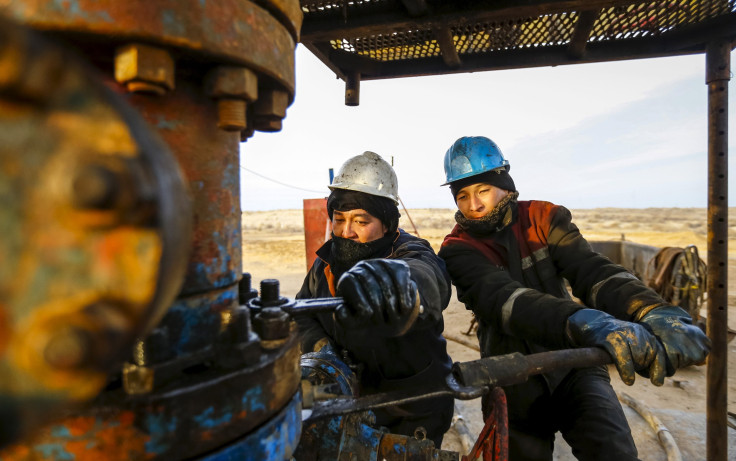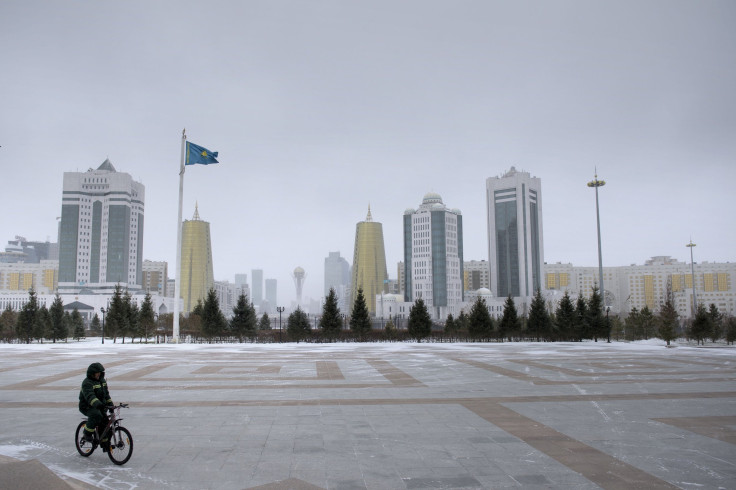Oil Squeeze: Kazakhstan And Central Asian States Suffer Amid Slowdowns In Russia And China

Amid the modern and futuristic landscape of Astana, Kazakhstan’s capital, and in the large city of Almaty, something rarely seen has appeared in recent weeks and months: protesters. Kazakhstan’s tenge currency was named the worst performing in the world last year, and if the first few weeks of 2016 are any indication, things are not improving for Central Asia’s largest energy exporter.
Caught between the struggling economies of Moscow and Beijing, Central Asian states are feeling the double impact of low global oil prices and the slowdown of two of the world’s largest economies. After Russia, Kazakhstan is the largest oil producer among the former Soviet states, and for the first time since 1998 its gross domestic product is expected to contract. With the government calling for early parliamentary elections in March amid worries of an intense economic slowdown, the possibility of more economically motivated protests lingers.
“[The] year 2016 will be a tough one for Central Asian economies, both resource-rich ones whose fortunes skydived together with the oil and gas prices, and resource-poor [ones] dependent on labor remittances from Russia,” Nargis Kassenova, an associate professor in the department of international relations and regional studies at KIMEP University in Almaty, the former capital, told International Business Times in an email. “Personally I notice rising prices and see people losing jobs.”
The five Central Asian nations – Kazakhstan, Kyrgyzstan, Tajikistan, Turkmenistan and Uzbekistan – for the most part experienced steady economic growth following the volatile 1990s, when Russia's financial crisis reverberated across the region, hitting the five former members of the Soviet Union. But with oil hovering around $30 a barrel, down from a high of more than $100 a barrel 18 months ago, revised economic forecasts show tough times for the year ahead. A GDP drop of more than 2 percent is predicted in Kazakhstan after the government shifted to a floating exchange rate last August.
President Nursultan Nazarbayev, 75, who has ruled the country since 1989, warned in October that a “real crisis is coming.” The government has tried to forestall the worst by increasing state pensions by 9 percent and public sector salaries by as much as 40 percent, Reuters reported. While financial reserves are likely to help Kazakhstan weather the next year, experts worry if oil prices remain low, 2017 could bring increasing instability.
“Next year, if the price dynamic continues at this level, there will be very serious questions about the ability to meet some of the commitments, including, most importantly, in regard to social welfare and salaries in the public sector,” said Alex Melikishvili, a senior analyst covering Europe and Central Asia for IHS, a global analysis firm.
The rare and small protests that have taken place in Kazakhstan have targeted financial issues, including the costs of mortgages held in foreign currencies. In an effort to shore up the legitimacy of the government, Kazakhstan is scheduled to hold early parliamentary elections in March that had originally been scheduled for late in 2016. With a weak and fractured opposition – experts have described Kazakhstan as an authoritarian state – few expect that the government, which has ruled without break since the fall of communism, will face much of a challenge.
We have revised our forecast for #Kazakhstan and now expect GDP to contract for the first time since 1998 pic.twitter.com/joBogDMXQi
— The EIU Europe (@TheEIU_Europe) January 22, 2016Central Asia has long defied predictions that it would become an area prone to instability, sharing borders with Iran and Afghanistan. Russia and China have competed as the biggest trading partners in the region with the Kremlin establishing the Eurasian Economic Union with Central Asian members Kazakhstan and Kyrgyzstan while Beijing launched its Silk Road initiative in the region in 2013. The initiative focuses on infrastructure and development projects worth billions of dollars building railroads and energy pipelines.
“The majority of these infrastructure projects are not going to happen in the time period between now and 2018 and 2019, when they were supposed to,” said Simeon Djankov, a visiting fellow at the Peterson Institute for International Economics in Washington and minister of finance of Bulgaria from 2009 to 2013. “So in other words it’s not only the oil and gas sector that is going to suffer, it’s also infrastructure and construction sector that starting to suffer as well.”
Uncertainty about China’s economy is coupled with a drastic decline in remittances from migrant workers in Russia. Both Tajikistan and Uzbekistan depend heavily on migrant workers, with more than 2 million Uzbeks working in Russia and more than 40 percent of Tajikistan’s GDP coming from remittance inflows, according to the World Bank. Kazakhstan also takes in migrant workers from neighboring states, resulting in a large economic trickle down of unemployed workers.

“As the Russian economy collapsed, many of these countries thought that China would be able to fill the gap, and China certainly could, but instability in Chinese markets right now is also causing many people to question the long-term economic trajectory of the region,” said Paul Stronski, a senior associate at the Carnegie Endowment for International Peace’s Russia and Eurasia Program.
While Nazarbayev has long spoken of modernizing and diversifying Kazakhstan’s economy, the oil price plunge has exposed the lack of reforms.
“What is worrying is that the government seems to be ill-prepared to effectively deal with the crisis and meet the challenges,” Kassenova said.
© Copyright IBTimes 2024. All rights reserved.












